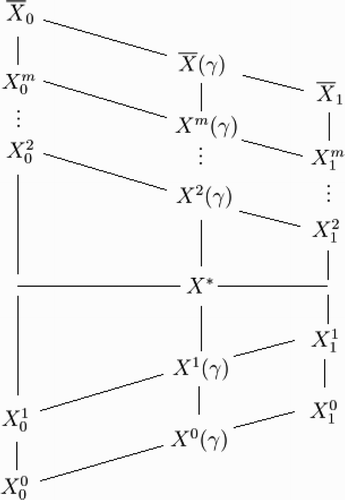Figures & data
Figure 1. The relative magnitudes of certain quantities appearing in the proof of Theorem 3. Some but not all quantities can be directly compared. Quantities appearing higher are provably larger than quantities that appear lower when they are path-connected by upward lines or ellipses. For example, is greater than X* and any quantity on the bottom two diagonals but less than any other quantity on the upper m diagonals. However, the relative position of X
2(γ) with respect to the quantities in the column above
is unknown.

Figure 2. Allocation profiles that are arbitrary on nontrivial intervals (rounded), piecewise constant on nontrivial intervals (rectangular), or with finite support (thick horizontal lines). In the first row, the allocation profiles are assumed to be the same. If ∀ appears in the upper left corner of a cell then the number of nontrivial stable (m) and unstable (n) equilibrium points satisfies the given conditions for all pairs of model species. However, if ∃ appears in the corner of a cell then there exist pairs of model species such that m and n both satisfy the given conditions. Degenerate situations under which two species nullclines coincide everywhere are excluded. A [p] or (q) in the lower right corner indicates that the result appears in citation [p] or as Theorem q in this article, respectively.
![Figure 2. Allocation profiles that are arbitrary on nontrivial intervals (rounded), piecewise constant on nontrivial intervals (rectangular), or with finite support (thick horizontal lines). In the first row, the allocation profiles are assumed to be the same. If ∀ appears in the upper left corner of a cell then the number of nontrivial stable (m) and unstable (n) equilibrium points satisfies the given conditions for all pairs of model species. However, if ∃ appears in the corner of a cell then there exist pairs of model species such that m and n both satisfy the given conditions. Degenerate situations under which two species nullclines coincide everywhere are excluded. A [p] or (q) in the lower right corner indicates that the result appears in citation [p] or as Theorem q in this article, respectively.](/cms/asset/70e1327d-1ee7-4ba4-8458-a42666cbe9c3/tjbd_a_385173_o_f0002g.gif)